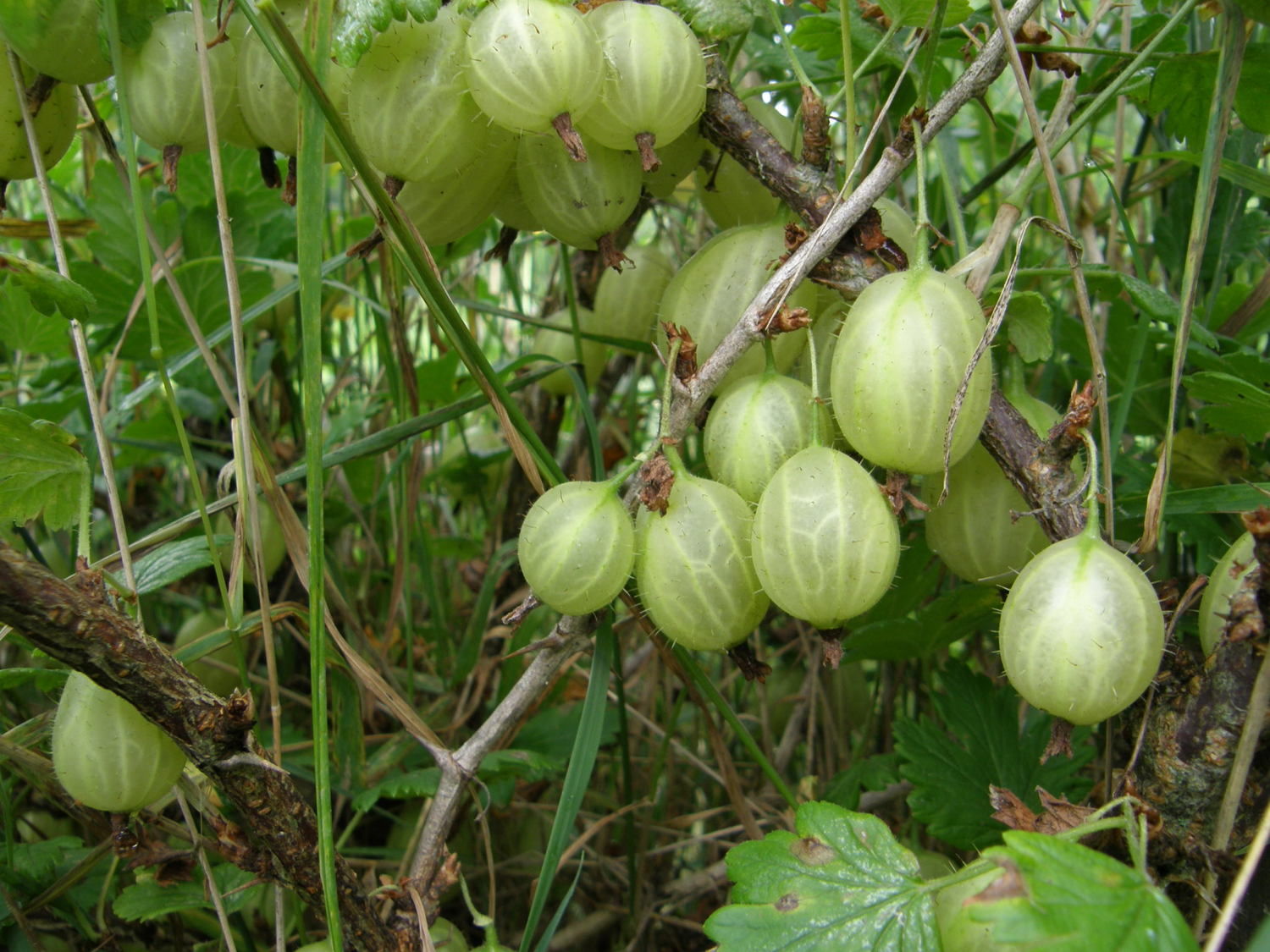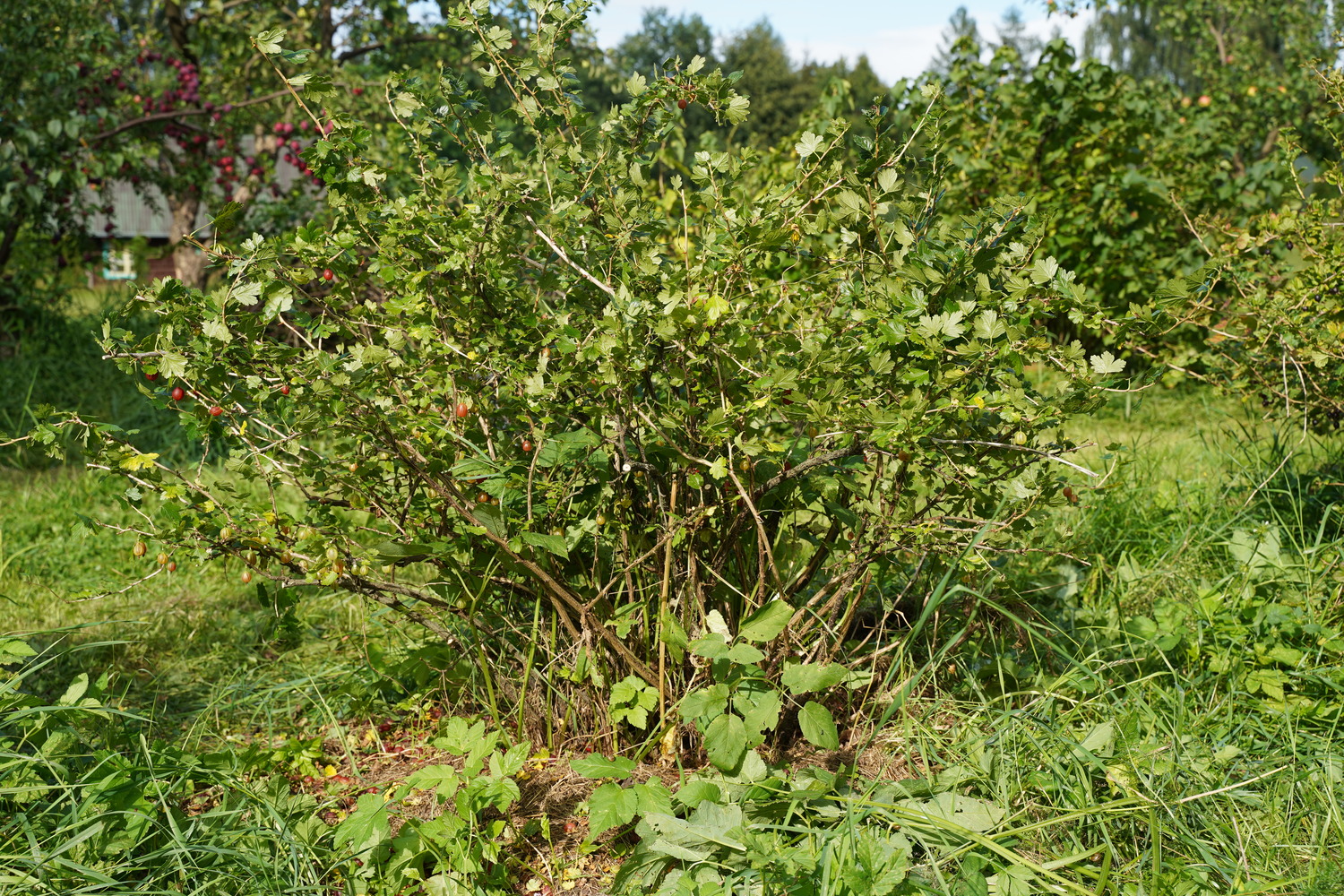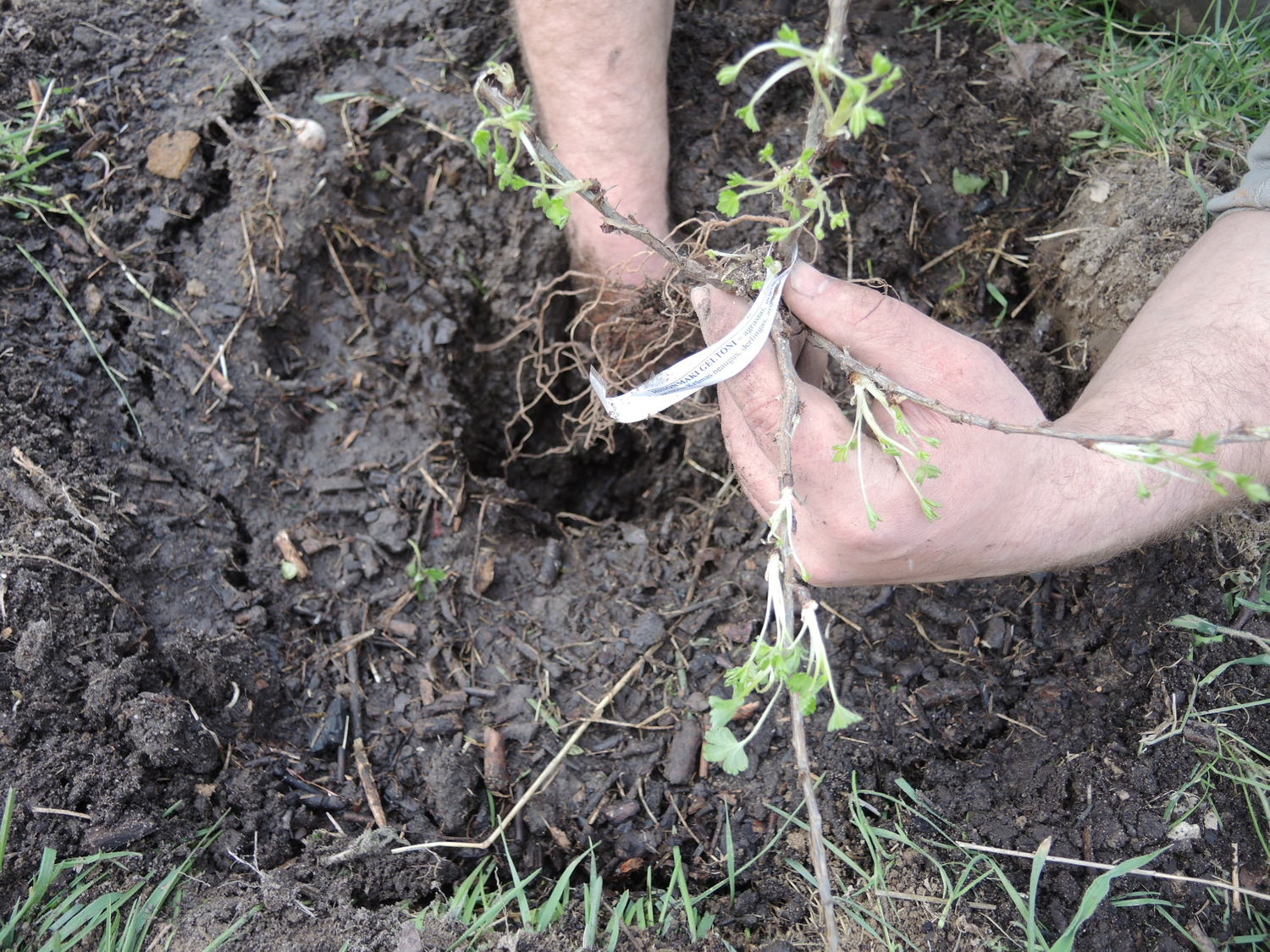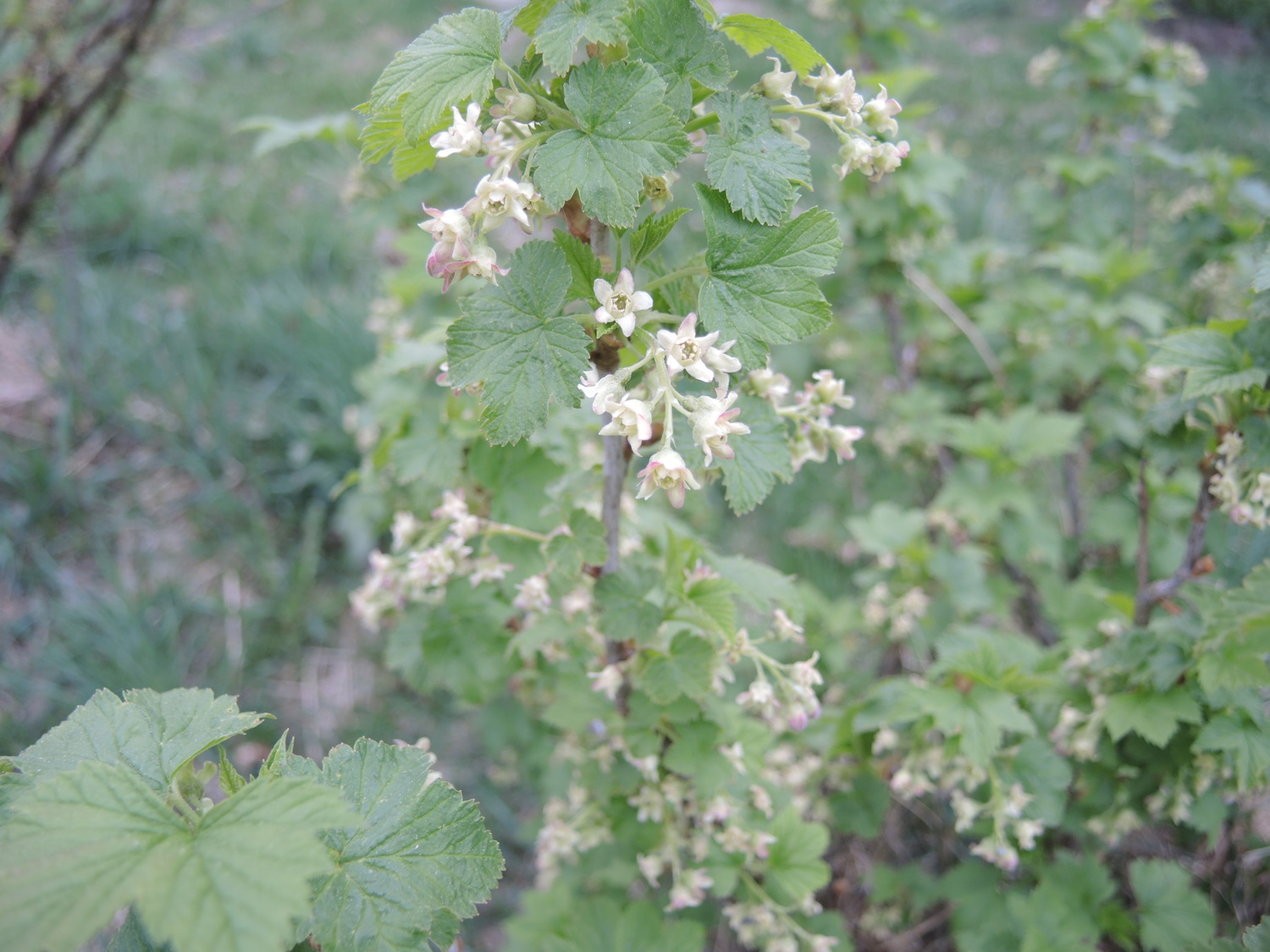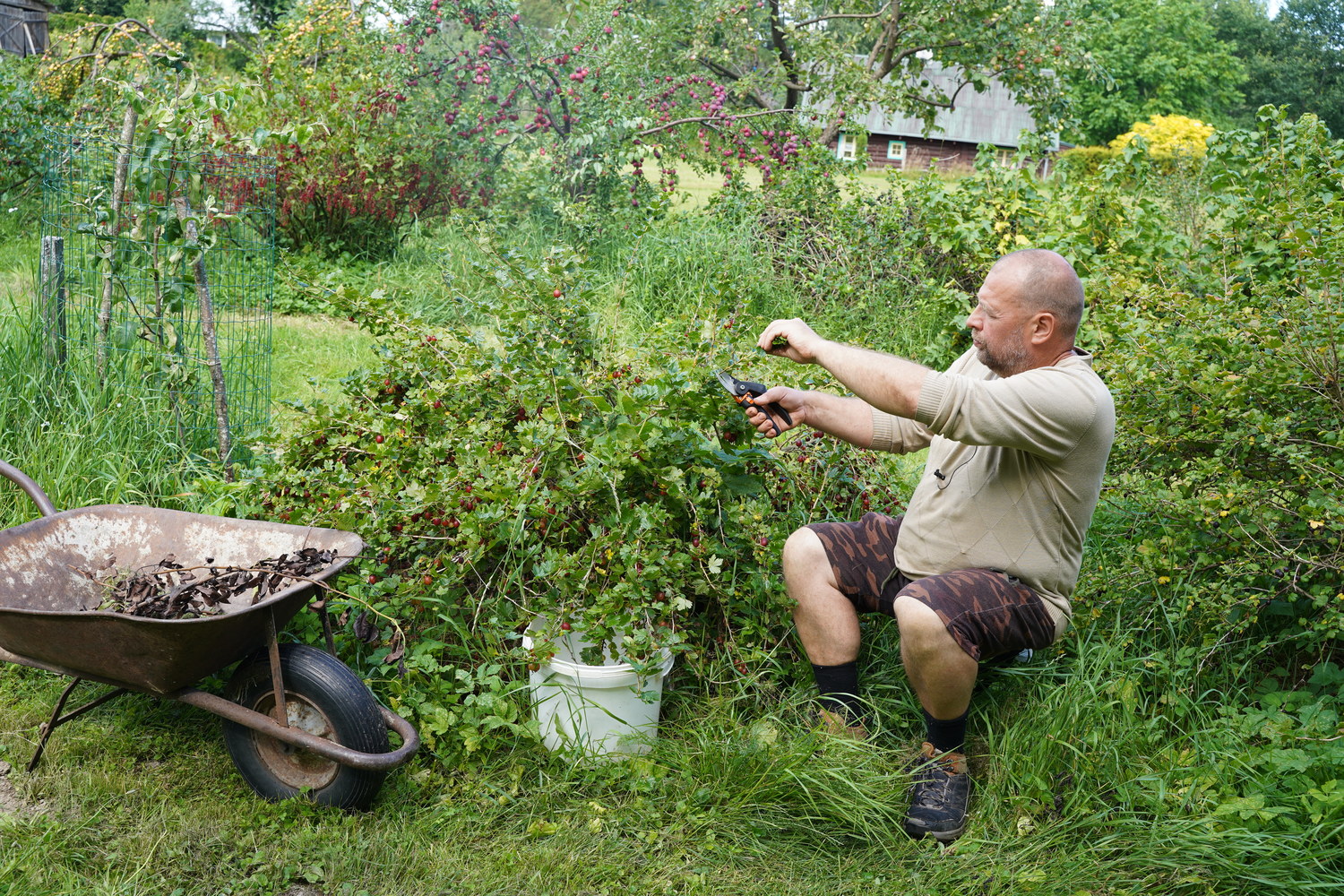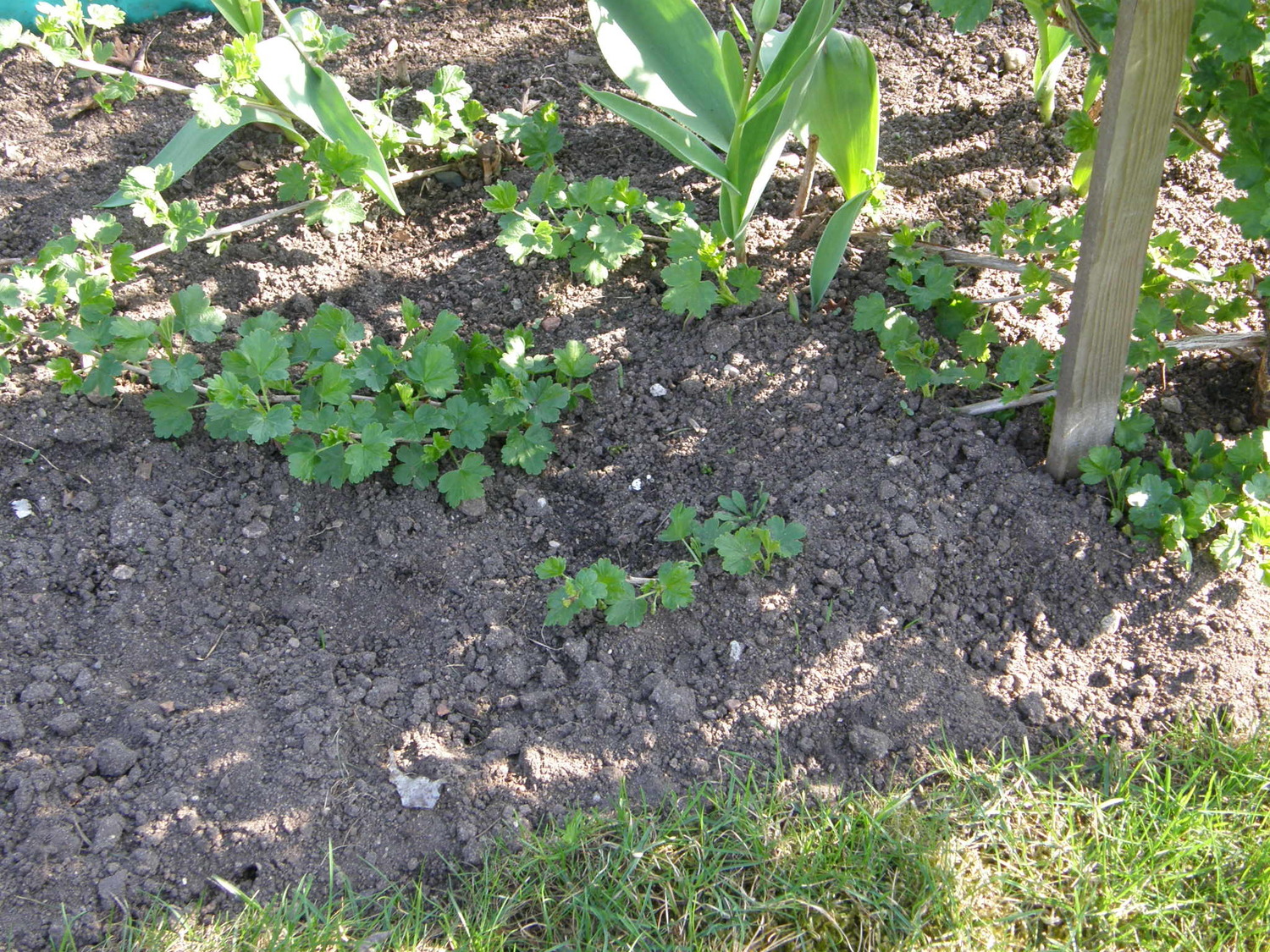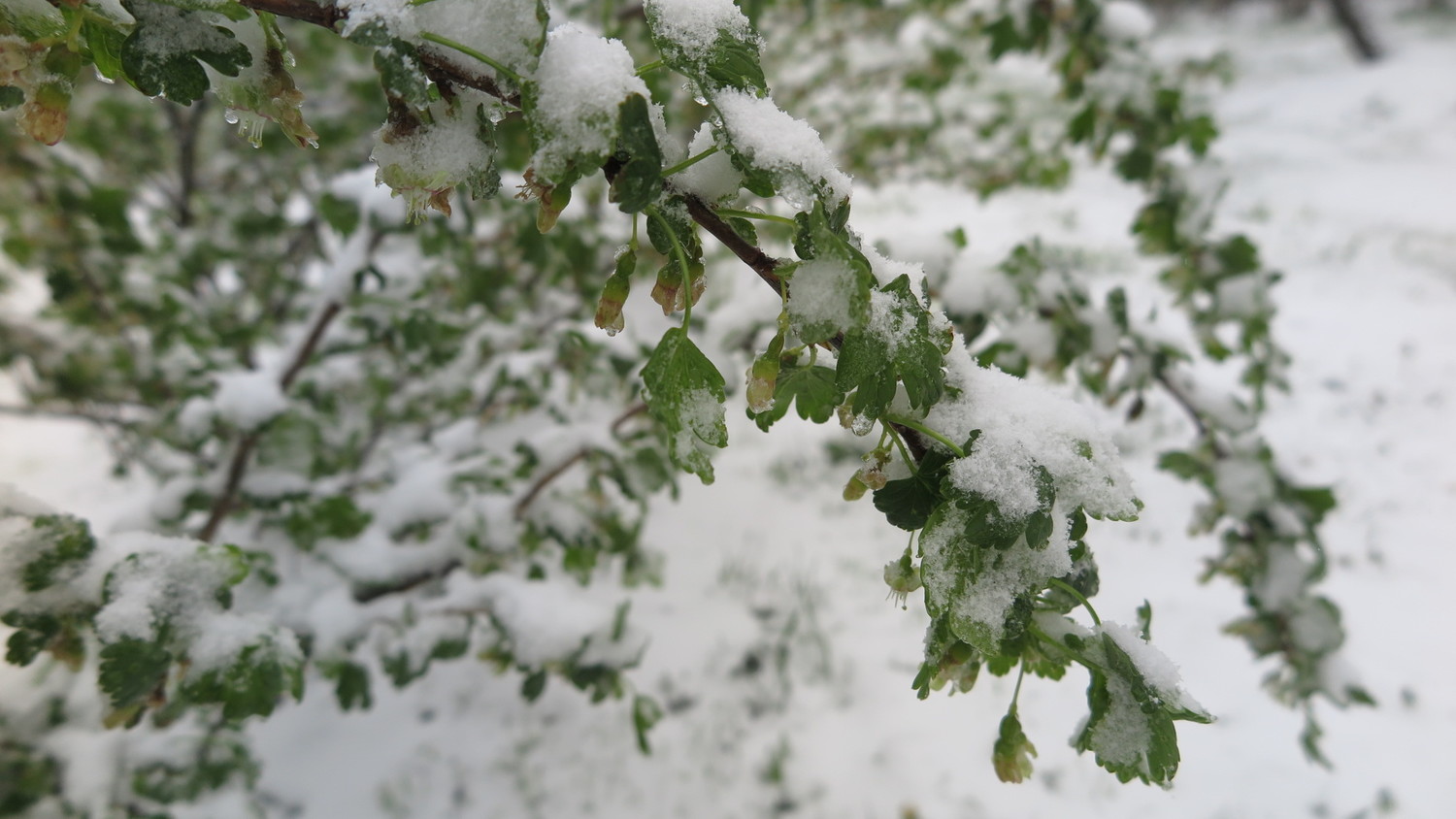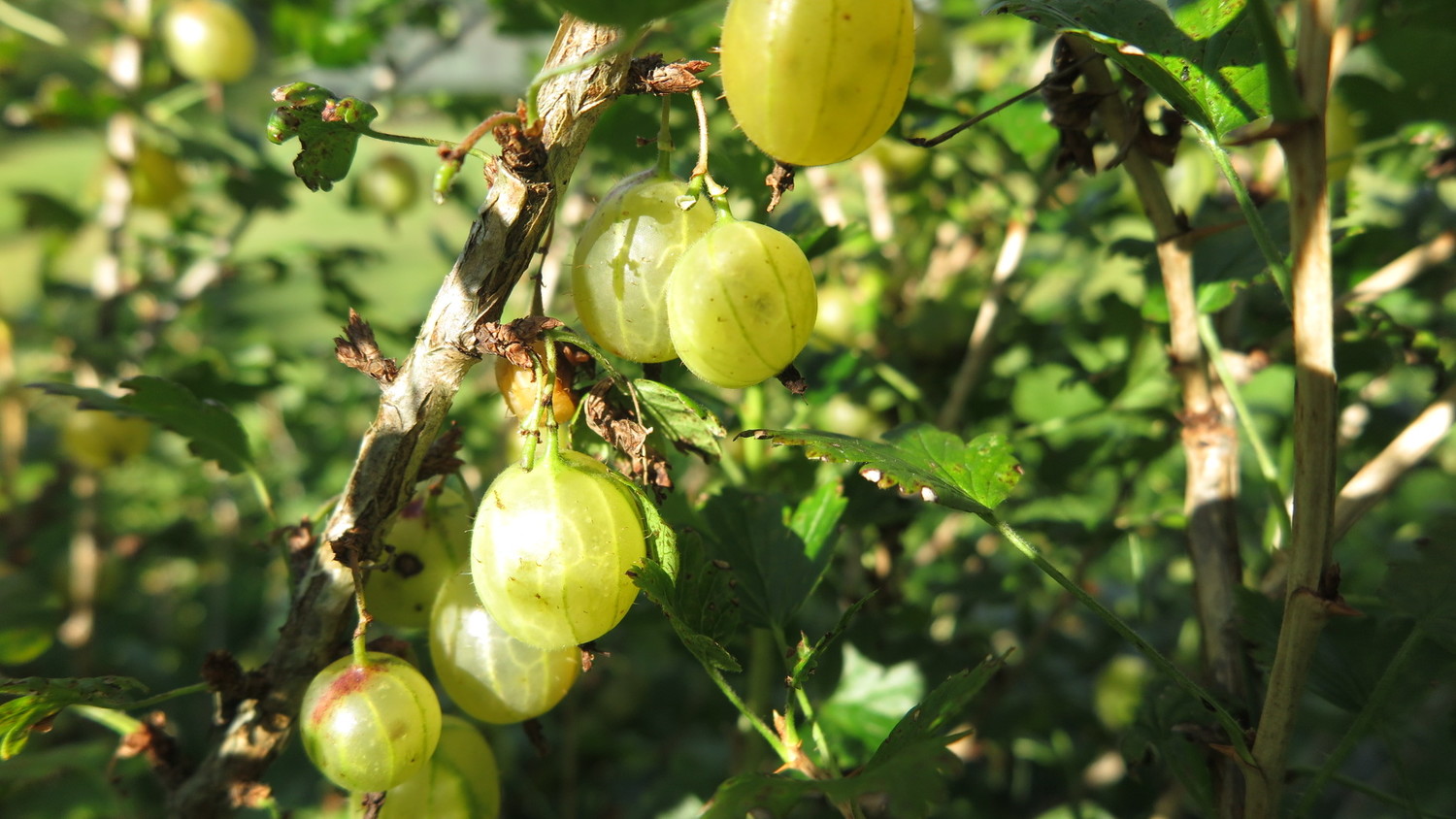Gooseberries (Latin: Ribes uva-crispa, English: gooseberry, German: Stachelbeere, Russian: крыжовник) are perennial berry shrubs from the Grossulariaceae family. They are undemanding, cold-hardy, and productive plants. The bushes can bear fruit for up to 30 years, although they are most productive during the first 15 years.
Choosing a Location for Gooseberry Planting
Gooseberries prefer a sunny location, although they can grow in slightly shaded areas. It's best to plant them in the middle or upper part of a slope in hilly regions. They like moist soil, but it should not be waterlogged—the groundwater level should be deeper than 1 to 1.5 meters. Gooseberries can grow in most soil types, but they thrive best in loamy or sandy loam soil that is neutral to slightly acidic (around ph 6). If the soil tends to get too wet in spring, it's recommended to form raised beds or ridges 15–25 cm high using loose soil.
Planting Gooseberry
Gooseberries are planted in holes about 40–50 cm in diameter and 30–40 cm deep. The spacing between rows should be 1.5–2 meters, and between plants 1–1.5 meters, depending on the variety's vigour, bushiness, and soil fertility. If planting in sandy soil, it's recommended to add a 5–7 cm layer of clay to the bottom of the hole and compact it. In clay soil, where water tends to accumulate, a drainage layer made of coarse gravel or crushed stone should be placed at the bottom of the hole. The hole is then filled with a loose mix of compost and fertile topsoil. In heavy soil, coarse sand can be mixed in, and in sandy soil, some loam should be added. Additionally, 15–20 g of superphosphate and 10–15 g of potassium chloride can be added per bucket of the soil mixture.
When planting commercial gooseberry plantations, the soil should be well-prepared, and all weeds, especially root weeds, must be eradicated. Depending on the soil fertility, the following is applied per square meter: 10 kg of compost, 30–40 g of superphosphate, and 15–20 g of potassium chloride.
It is best to plant gooseberries in the fall (late September) or early spring, before the buds open. Gooseberries grown in containers or pots can be planted from spring to autumn.
When planting:
- Broken twigs are removed, and roots are trimmed to about 20 cm.
- Gooseberries are planted so that 5–6 cm of the stem below the root collar is buried underground.
- In loamy soil, the seedling should be planted at an angle to encourage additional root growth.
- For bare-root seedlings, roots are spread out, carefully covered with soil mixture, and gently compacted.
- The planted shrub is watered with a bucket of water.
When planting bare-root seedlings, the stems are pruned back to 3–4 buds.
A gooseberry grown in a container will already bear fruit the following year.
Growing Gooseberries
Gooseberries are not very demanding in terms of care. In clay soil, the ground around the bushes should be loosened or mulched with dried lawn grass. In lighter, less fertile loam soil, gooseberries should be fertilised annually with organic fertilisers (compost and mineral fertilisers are best). Each bush needs a bucket of compost, 20–30 g of potassium sulfate (do not use potassium chloride), and 50–80 g of superphosphate. In more fertile soils, gooseberries can be fertilised every second year, but it’s better to apply smaller amounts annually. A lack of potassium causes browning of leaf edges. Fertilisation should be done first at the end of March, right after flowering, and again after harvest to help the plant prepare for winter. After flowering, it’s recommended to apply additional fertiliser using fermented cow or poultry manure.
Flowering gooseberries
Although gooseberries are self-pollinating, they produce better yields when more gooseberry bushes grow nearby.
Gooseberry bushes need to have horizontal branch supports. Depending on the variety and the length of the branches, a 20-40 cm high enclosure is made.
Gooseberry Pruning
Gooseberries are pruned to thin the bush and reduce the risk of fungal diseases. By regularly renewing the branches and leaving only the most productive ones, higher yields can be expected. The most valuable branches are usually 5-7 years old. When pruning, leave as many strong first-year shoots as the number of old branches removed. Older branches are not shortened but cut off at the base. A gooseberry bush should have 20-25 branches.
Summer pruning is important when harvesting the crop. During this pruning, first-year shoots can be shortened. Usually, gooseberries stop producing side shoots but begin accumulating nutrients in the remaining buds, including those from previous years. This way, the bush remains compact and fruitful on older branches. If gooseberry branches are not pruned, they elongate, and the lower parts of the branches start to wither.
Pruning the tips of last year's branches in spring results in the loss of the strongest flower buds.
The largest gooseberries are found in the last buds of last year's branches. If not pruned in summer, the branches will become long and lie on the ground.
Propagation of Gooseberries
Gooseberries are very easy to propagate by layering. Healthy, productive bushes are selected, and only healthy, strong lateral shoots are bent. The rooting area should be loosened, and compost can be used. The bent shoot is pressed down and covered with a layer of soil, and grass mulch can be added. Spring layers will have developed into strong bushes by autumn, which can be separated from the main bush without digging. The new bush can be transplanted to its permanent location in the next spring or autumn.
Gooseberries can be propagated by green cuttings. The optimal time is in June, after active vegetation stops. The cuttings should be 5-7 cm long, and the tips should not be cut off or the leaves shortened. The cuttings are prepared for planting using growth stimulants. They are then inserted 2 cm into a mixture of peat and sand (1:1). The substrate temperature should be 18-20°C. Watering is done by spraying with a pulveriser. After rooting, the cuttings can be watered with a mixture of mineral fertilisers (nitrogen, phosphorus, potassium in a 1:2:1 ratio) at a 1% solution.
Gooseberry Varieties
European gooseberry varieties produce large berries, but they are less resistant to mildew. By crossing them with American varieties (which have smaller berries), more mildew-resistant varieties are obtained. American varieties are also of larger growth. The hybrid varieties stand out with larger berries than the American ones, improved resistance to diseases and cold, and higher yields.
Gooseberry Pests and Diseases
Gooseberry mildew is caused by gooseberry mildew fungi, and it is particularly dangerous for older European large-fruited varieties. More resistant varieties are developed by crossing with North American gooseberry varieties. The symptoms of the disease appear in mid-summer, with white, web-like fungal growth appearing on young leaves, shoots, and berries. Later, the growth turns brown, thickens, and becomes felt-like. Leaves begin to dry, curl, but remain on the stems, and shoots become deformed. The berries are covered with a coating, crack, and become unusable.
The disease spreads in moist and warm weather. Over-fertilisation, especially with nitrogen fertilisers, is also harmful. To reduce the risk of mildew, gooseberries should not be planted in shady areas, and the bush must be pruned and dead branches removed. In the fall, it is recommended to burn the leaves and fallen berries. Before flowering and after harvesting the berries, systemic fungicides should be used for spraying.
Gooseberry Alternaria, caused by the gooseberry dry rot fungus (Alternaria grossulariae), affects berries, leaves, and shoots. Large, round, brown-gray, shiny spots appear on the leaves. The leaves drop early, shoots turn black and dry, berries shrink, rot, harden, wrinkle, and eventually fall off. The disease is most commonly found in shaded, unpruned, and densely planted gooseberry bushes.
To prevent the disease, remove affected leaves, berries, and diseased branches. Everything should be buried or burned. Spraying with fungicides is also recommended to control the disease.
Gooseberry anthracnose spreads on leaves, young shoots, and berries. Small, irregularly shaped dark brown spots, about 1 mm in size, appear on the leaves during summer. Later, these spots turn black, become shiny, and increase in size two to three times. As the disease progresses, the spots merge, the leaves start to curl, rust, and dry out. Berries ripen more slowly, become hard, and lose flavour. Weakened plants may suffer from frost damage during winter.
The disease usually starts on the lower leaves and gradually affects the whole plant, leaving only the stems with young leaves. The disease thrives in shady, damp, and cool conditions. To prevent it, remove infected leaves, berries, and stems. Potassium fertilisation helps. Fungicide applications should be made before, after blooming, and after harvesting the berries.
Gooseberry powdery mildew is a common disease caused by the gooseberry powdery mildew fungus. The disease affects only the leaves, causing a white, web-like fungal growth on the upper side of the leaves. Affected leaves finish their growth prematurely and dry out.
The disease, gooseberry leaf spot, is caused by the currant sphere fungus. It is one of the most damaging diseases, affecting leaves, young shoots, buds, and sometimes berries. Initially, small round or angular spots of 2-3 mm in size appear on the leaves. These spots are brown at first, then lighten in colour with a narrow brown margin. As the disease progresses, the spots merge, the leaves begin to dry, and eventually fall off. Affected shoots stop growing, and the berries become smaller.
The disease is encouraged by high temperatures and humidity, and it develops better in unpruned and densely planted bushes. The first signs of the disease appear in May, and it spreads most notably during mid-summer. Protection methods are similar to those used for anthracnose.
Ascochyta blight is caused by the fungus Ascochyta ribesia. The symptoms of the disease include round spots that start as brown and later turn grey with brown edges. The affected areas dry out, and the part of the leaf with the spots falls off.
Protection measures for Ascochyta blight are the same as for gooseberry leaf spot and Alternaria.
Vixyvine rust is a common disease of gooseberries caused by oat rust. It affects young parts of the plant, leaves, flowers, and developing berries. Reddish-brown or yellow-orange spots appear on the upper side of the leaves. The affected leaves begin to dry out and fall off, and the berries shrink and drop off. The spores of the disease-causing agent overwinter in oats, so these should be mowed around the currants. Fungicides should be applied before and after blooming.
Blister rust is the causative agent is the common red blister fungus. It enters the plant through wounds, damages stems, branches, and young shoots. The fungus blocks the capillaries when it enters them. Affected branches quickly dry out. The fungus overwinters in the damaged wood. In the spring, it is easy to distinguish infected branches as small blisters containing the fungus spores appear on the bark surface. Rain and insects spread the spores around. As a preventive measure, remove the damaged, dried branches.
Gooseberry Use
Gooseberries are used both fresh and preserved. Unripe berries are used to make compotes, semi-ripe berries are used for jams, and fully ripe berries are used for jellies and desserts. Gooseberries also make excellent wines.

